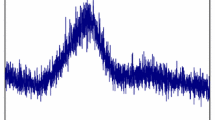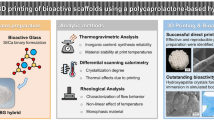Abstract
Wollastonite (CaSiO3)–diopside (CaMgSi2O6) glass-ceramic scaffolds have been successfully fabricated using two different additive manufacturing techniques: powder-based 3D printing (3DP) and digital light processing (DLP), coupled with the sinter-crystallization of glass powders with two different compositions. The adopted manufacturing process depended on the balance between viscous flow sintering and crystallization of the glass particles, in turn influenced by the powder size and the sensitivity of CaO–MgO–SiO2 glasses to surface nucleation. 3DP used coarser glass powders and was more appropriate for low temperature firing (800–900 °C), leading to samples with limited crystallization. On the contrary, DLP used finer glass powders, leading to highly crystallized glass-ceramic samples. Despite the differences in manufacturing technology and crystallization, all samples featured very good strength-to-density ratios, which benefit their use for bone tissue engineering applications. The bioactivity of 3D-printed glass-ceramics after immersion in simulated body fluid and the similarities, in terms of ionic releases and hydroxyapatite formation with already validated bioactive glass-ceramics, were preliminarily assessed.









Similar content being viewed by others
References
R. Gmeiner, U. Deisinger, J. Schönherr, B. Lechner, R. Detsch, A.R. Boccaccini, and J. Stampfl: Additive manufacturing of bioactive glasses and silicate bioceramics. J. Ceram. Sci. Technol. 6, 75 (2015).
K. Chopra, P. Mummery, B. Derby, and J. Gough: Gel-cast glass-ceramic tissue scaffolds of controlled architecture produced via stereolithography of moulds. Biofabrication 4, 045002 (2012).
S. Padilla, S. Sánchez-Salcedo, and M. Vallet-Regí: Bioactive glass as precursor of designed-architecture scaffolds for tissue engineering. J. Biomed. Mater. Res., Part A 81, 224 (2007).
T-M.G. Chu, J.W. Halloran, S.J. Hollister, and S.E. Feinberg: Hydroxyapatite implants with designed internal architecture. J. Mater. Sci. Mater. Med. 12, 471 (2001).
S. Limpanuphap and B. Derby: Manufacture of biomaterials by a novel printing process. J. Mater. Sci. Mater. Med. 13, 1163 (2002).
Q. Fu, E. Saiz, and A.P. Tomsia: Bioinspired strong and highly porous glass scaffolds. Adv. Funct. Mater. 22, 1058 (2011).
M.N. Rahaman, D.E. Day, B.S. Bal, Q. Fu, S.B. Jung, L.F. Bonewald, and A.P. Tomsia: Bioactive glass in tissue engineering. Acta Biomater. 7, 2355 (2011).
Q. Fu, E. Saiz, M.N. Rahaman, and A.P. Tomsia: Bioactive glass scaffolds for bone tissue engineering: State of the art and future perspectives. Mater. Sci. Eng., C 31, 1245 (2011).
A.M. Deliormanlı and M.N. Rahaman: Direct-write assembly of silicate and borate bioactive glass scaffolds for bone repair. J. Eur. Ceram. Soc. 32, 3637 (2012).
S. Eqtesadi, A. Motealleh, A. Pajares, and P. Miranda: Effect of milling media on processing and performance of 13-93 bioactive glass scaffolds fabricated by robocasting. Ceram. Int. 41, 1379 (2015).
L.L. Hench and T. Kokubo: Properties of bioactive glasses and glass-ceramics. In Handbook of Biomaterial Properties, J. Black and G. Hastings, eds. (Chapman & Hall, London, 1998); pp. 355–563.
P. Tesavibul, R. Felzmann, S. Gruber, R. Liska, I. Thompson, A.R. Boccaccini, and J. Stampfl: Processing of 45S5 Bioglass® by lithography-based additive manufacturing. Mater. Lett. 74, 81 (2012).
A. Winkel, R. Meszaros, S. Reinsch, R. Müller, N. Travitzky, T. Fey, P. Greil, and L. Wondraczek: Sintering of 3D-printed glass/HAp composites. J. Am. Ceram. Soc. 95, 3387 (2012).
A.R. Boccaccini, Q. Chen, L. Lefebvre, L. Gremillard, and J. Chevalier: Sintering, crystallisation and biodegradation behaviour of Bioglass®-derived glass-ceramics. Faraday Discuss. 136, 27 (2007).
F. Baino, M. Ferraris, O. Bretcanu, E. Verné, and C. Vitale-Brovarone: Optimization of composition, structure and mechanical strength of bioactive 3-D glass-ceramic scaffolds for bone substitution. J. Appl. Biomater. 27, 872 (2013).
H. Elsayed, A.R. Romero, L. Ferroni, C. Gardin, B. Zavan, and E. Bernardo: Bioactive glass-ceramic scaffolds from novel ‘inorganic gel casting’ and sinter-crystallization. Materials 10, 171 (2017).
O. Peitl, G.P. LaTorre, and L.L. Hench: Effect of crystallization on apatite-layer formation of bioactive glass 45S5. J. Biomed. Mater. Res. 30, 509 (1996).
O. Peitl, E.D. Zanotto, and L.L. Hench: Highly bioactive P2O5–Na2O–CaO–SiO2 glass-ceramic. J. Non-Cryst. Solids 292, 115 (2001).
R. Meszaros, R. Zhao, N. Travitzky, T. Fey, P. Greil, and L. Wondraczek: Three-dimensional printing of a bioactive glass. Glass Technol.: Eur. J. Glass Sci. Technol., Part A 52, 111 (2011).
M. Montazerian and E.D. Zanotto: History and trends of bioactive glass-ceramics. J. Biomed. Mater. Res., Part A 104, 1231 (2016).
R. Müller, E.D. Zanotto, and V.M. Fokin: Surface crystallization of silicate glasses: Nucleation sites and kinetics. J. Non-Cryst. Solids 274, 208 (2000).
M.O. Prado and E.D. Zanotto: Glass sintering with concurrent crystallization. Compt. Rendus Chem. 5, 773 (2002).
A.A. Francis, R.D. Rawlings, R. Sweeney, and A.R. Boccaccini: Crystallization kinetic of glass particles prepared from a mixture of coal ash and soda-lime cullet glass. J. Non-Cryst. Solids 333, 187 (2004).
M.S. Hernández-Crespo, M. Romero, and J.M. Rincón: Nucleation and crystal growth of glasses produced by a generic plasma arc-process. J. Eur. Ceram. Soc. 26, 1679 (2006).
E. Bernardo, G. Scarinci, E. Edme, U. Michon, and N. Planty: Fast-sintered gehlenite glass-ceramics from plasma-vitrified municipal solid waste incinerator fly ashes. J. Am. Ceram. Soc. 92, 528 (2009).
A. Ray and A.N. Tiwari: Compaction and sintering behaviour of glass-alumina composites. Mater. Chem. Phys. 67, 220 (2001).
S.F. Hulbert, S.J. Morrison, and J.J. Klawitter: Tissue reaction to three ceramics of porous and non-porous structures. J. Biomed. Mater. Res. 6, 347 (1972).
M.A. Sainz, P. Pena, S. Serena, and A. Caballero: Influence of design on bioactivity of novel CaSiO3–CaMg(SiO3)2 bioceramics: In vitro simulated body fluid test and thermodynamic simulation. Acta Biomater. 6, 2797 (2010).
A. Börger, P. Supancic, and R. Danzer: The ball on three balls test for strength testing of brittle discs: Stress distribution in the disc. J. Eur. Ceram. Soc. 22, 142 (2002).
H. Elsayed, P. Colombo, and E. Bernardo: Direct ink writing of wollastonite-diopside glass-ceramic scaffolds from a silicone resin and engineered fillers. J. Eur. Ceram. Soc. 37, 4187 (2017).
A. Karamanov and M. Pelino: Induced crystallization porosity and properties of sintered diopside and wollastonite glass-ceramics. J. Eur. Ceram. Soc. 28, 555 (2008).
A.R. Boccaccini: On the viscosity of glass composites containing rigid inclusions. Mater. Lett. 34, 285 (1998).
R. Müller, M. Eberstein, S. Reinsch, W.A. Schiller, J. Deubener, and A. Thiel: Effect of rigid inclusions on sintering of low temperature co-fired ceramics. Phys. Chem. Glasses: Eur. J. Glass Sci. Technol., Part B 48, 259 (2007).
M.O. Prado, E.B. Ferreira, and E.D. Zanotto: Sintering kinetics of crystallizing glass particles. Ceram. Trans. 170, 163 (2005).
A.A. Reddy, D.U. Tulyaganov, M.J. Pascual, V.V. Kharton, E.V. Tsipis, V.A. Kolotygin, and J.M.F. Ferreira: SrO-containing diopside glass-ceramic sealants for solid oxide fuel cells: Mechanical reliability and thermal shock resistance. Fuel Cells 13, 689 (2013).
I.D. Thompson and L.L. Hench: Mechanical properties of bioactive glasses, glass-ceramics and composites. Proc. Inst. Mech. Eng., Part H 212, 127 (1998).
M.N. Rahaman, X. Liu, and T.S. Huang: Bioactive glass scaffolds for the repair of load-bearing bones. In Advances in Bioceramics and Porous Ceramics, Vol. 32, R. Narayan and P. Colombo, eds. (John Wiley & Sons, pmHoboken, New Jersey, United States, 2009); p. 65.
L.J. Gibson and M.F. Ashby: Cellular Solids, Structure and Properties, 2nd ed. (Cambridge University Press, Cambridge, U.K., 1999).
T. Nakamura, T. Yamamuro, S. Higashi, T. Kokubo, and S. Itoo: A new glass-ceramic for bone replacement: Evaluation of its bonding to bone tissue. J. Biomed. Mater. Res. 19, 685 (1985).
T. Kokubo: Bioceramics and Their Clinical Applications (Elsevier, New York City, New York, United States, 2008).
J.X. Lu, M. Descamps, J. Dejou, G. Koubi, P. Hardouin, J. Lemaitre, and J.P. Proust: The biodegradation mechanism of calcium phosphate biomaterials in bone. J. Biomed. Mater. Res. 63, 408 (2002).
C. Ohtsuki, T. Kokubo, and T. Yamamuro: Mechanism of apatite formation on CaOSiO2P2O5 glasses in a simulated body fluid. J. Non-Cryst. Solids 143, 84 (1992).
C. Wu and J. Chang: A review of bioactive silicate ceramics. Biomed. Mater. 8, 032001 (2013).
P. Siriphannon, Y. Kameshima, A. Yasumori, K. Okada, and S. Hayashi: Formation of hydroxyapatite on CaSiO3 powders in simulated body fluid. J. Eur. Ceram. Soc. 22, 511 (2002).
Y. Iimori, Y. Kameshima, K. Okada, and S. Hayashi: Comparative study of apatite formation on CaSiO3 ceramics in simulated body fluids with different carbonate concentrations. J. Mater. Sci.: Mater. Med. 16, 73 (2005).
E. Salahinejad and R. Vahedifard: Deposition of nanodiopside coatings on metallic biomaterials to stimulate apatite-forming ability. Mater. Des. 123, 120 (2017).
ACKNOWLEDGMENTS
Hamada Elsayed gratefully acknowledges the financial support of the Cultural Affairs and Missions Sector, Egypt. The authors thank Mr. Carlo Castegini and Ms. Ilaria Baesso (University of Padova) for experimental assistance.
Author information
Authors and Affiliations
Corresponding author
Additional information
This author was an editor of this journal during the review and decision stage. For the JMR policy on review and publication of manuscripts authored by editors, please refer to http://www.mrs.org/editor-manuscripts/.
Rights and permissions
About this article
Cite this article
Elsayed, H., Zocca, A., Schmidt, J. et al. Bioactive glass-ceramic scaffolds by additive manufacturing and sinter-crystallization of fine glass powders. Journal of Materials Research 33, 1960–1971 (2018). https://doi.org/10.1557/jmr.2018.120
Received:
Accepted:
Published:
Issue Date:
DOI: https://doi.org/10.1557/jmr.2018.120




